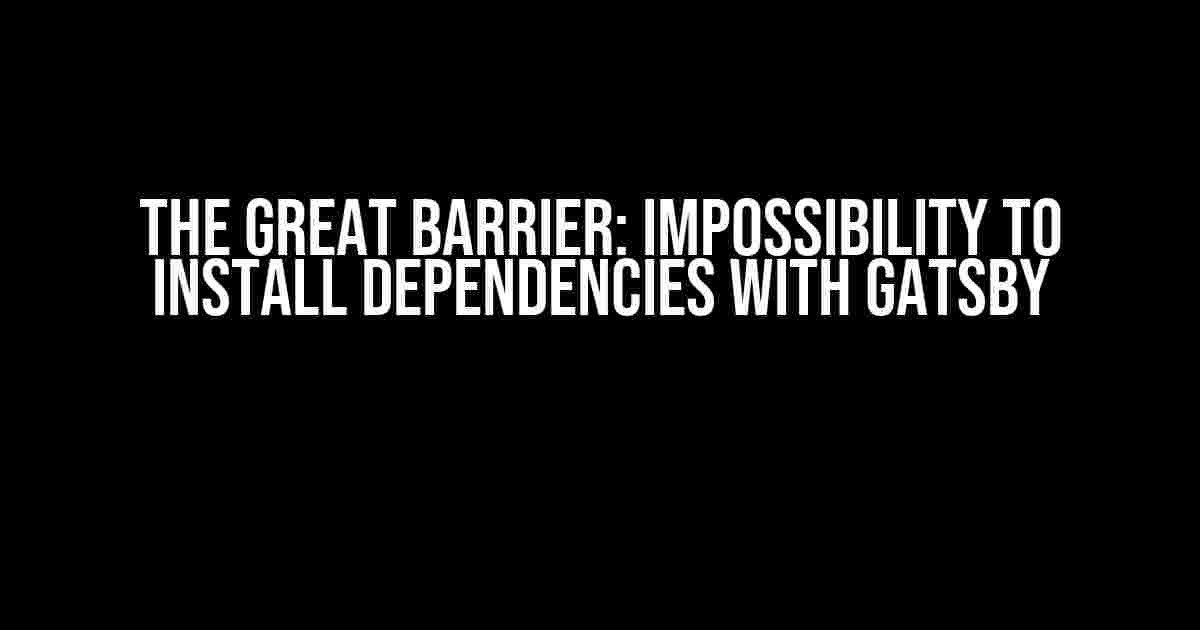Are you tired of banging your head against the wall, trying to install dependencies with Gatsby, only to be met with frustrating error messages and unending frustration? You’re not alone! In this comprehensive guide, we’ll delve into the world of Gatsby dependencies, exploring the common pitfalls and providing clear, step-by-step instructions to help you overcome the impossibility of installing dependencies.
Understanding Gatsby Dependencies
Gatsby, the popular React-based framework, relies heavily on dependencies to function. These dependencies can range from plugins for SEO optimization to libraries for image compression. However, the process of installing these dependencies can be a daunting task, especially for beginners.
Before we dive into the solutions, let’s take a step back and understand the anatomy of a Gatsby project. A typical Gatsby project consists of:
gatsby-config.js: The central configuration file for your Gatsby project.package.json: The file that lists all dependencies and scripts required for your project.yarn.lockorpackage-lock.json: The file that tracks the versions of installed dependencies.- Node modules (
node_modules): The directory that contains all installed dependencies.
Common Issues with Installing Dependencies
So, what can go wrong during the installation process? Here are some common issues you might encounter:
npmoryarnerrors: Errors can occur due to syntax mistakes, corrupted package files, or conflicts with existing dependencies.- Version conflicts: Different versions of dependencies can cause conflicts, leading to installation failures.
- Missing dependencies: Forgetting to install required dependencies can cause errors during the build process.
- Plugin incompatibilities: Some plugins might be incompatible with your Gatsby version or other dependencies.
- Circular dependencies: A dependency requiring another dependency, which in turn requires the first dependency, can create a circular dependency nightmare.
Step-by-Step Guide to Installing Dependencies
Now that we’ve covered the common issues, let’s walk through the step-by-step process of installing dependencies with Gatsby:
Step 1: Update Your Package Manager
Ensure you’re running the latest version of npm or yarn. You can update npm using the following command:
npm install -g npm@latestFor yarn, run:
yarn global add yarn@latestStep 2: Create a New Gatsby Project (Optional)
If you’re starting from scratch, create a new Gatsby project using:
npx gatsby new my-gatsby-projectReplace my-gatsby-project with your desired project name.
Step 3: Install Dependencies
Install dependencies using npm or yarn. For example, to install the gatsby-plugin-seo plugin, run:
npm install gatsby-plugin-seoor
yarn add gatsby-plugin-seoMake sure to include the dependency in your gatsby-config.js file:
module.exports = {
plugins: [
`gatsby-plugin-seo`,
],
};Step 4: Verify Dependency Installation
Verify that the dependency has been installed correctly by checking the node_modules directory and the yarn.lock or package-lock.json file.
Troubleshooting Common Errors
Encountered an error during installation? Don’t worry! Here are some common error messages and their solutions:
| Error Message | Solution |
|---|---|
npm ERR! code ELOCKVERIFY |
Delete the package-lock.json file and run npm install again. |
yarn error Failed to replace env in * |
Delete the yarn.lock file and run yarn install again. |
Cannot find module 'gatsby-plugin-seo' |
Verify that the dependency is installed correctly and included in the gatsby-config.js file. |
Best Practices for Managing Dependencies
To avoid common issues and ensure smooth dependency management, follow these best practices:
- Use a consistent package manager: Stick to either
npmoryarnto avoid compatibility issues. - Keep your dependencies up-to-date: Regularly update your dependencies to ensure you have the latest versions.
- Use a dependency manager like Lerna: Lerna helps you manage multiple dependencies and plugins in a single project.
- Test dependencies before deployment: Verify that your dependencies are working as expected before deploying your Gatsby site.
- Document your dependencies: Keep a record of the dependencies you’re using, including their versions and configuration.
Conclusion
Installing dependencies with Gatsby can be a daunting task, but with this comprehensive guide, you’re now equipped to overcome the impossibility of installing dependencies. Remember to follow best practices, troubleshoot common errors, and verify dependency installation to ensure a smooth Gatsby development experience.
Don’t let dependency installation hold you back from creating amazing Gatsby projects. Happy coding!
Frequently Asked Question
Got stuck with Gatsby and struggling to install dependencies? Don’t worry, we’ve got you covered! Here are some common questions and answers to help you overcome the impossibility to install dependencies with Gatsby.
Why does Gatsby fail to install dependencies?
Gatsby might fail to install dependencies due to several reasons such as outdated package versions, conflicts with other dependencies, or even a poor internet connection. It’s essential to check the error logs and identify the root cause of the issue to resolve it effectively.
What are some common dependency issues in Gatsby?
Some common dependency issues in Gatsby include conflicting versions of React, incompatible dependencies, or missing peer dependencies. Additionally, issues with npm or yarn, such as cache corruption or network connectivity problems, can also cause dependency installation failures.
How can I troubleshoot dependency installation issues in Gatsby?
To troubleshoot dependency installation issues in Gatsby, try the following steps: 1) Check the error logs for specific error messages, 2) Verify that your package versions are up-to-date, 3) Run `gatsby clean` to remove cache and try re-installing dependencies, 4) Check for conflicting dependencies, and 5) Try installing dependencies individually to identify the problematic one.
Can I use a specific version of a dependency in Gatsby?
Yes, you can specify a specific version of a dependency in Gatsby by using the `resolutions` field in your `package.json` file. For example, you can add `”resolutions”: {“dependency-name”: “version”}` to force Gatsby to install a specific version of the dependency.
What if I’m still stuck with dependency installation issues in Gatsby?
If you’re still stuck with dependency installation issues in Gatsby, feel free to seek help from the Gatsby community or post an issue on the Gatsby GitHub repository. You can also try searching for similar issues on the internet or consult the Gatsby documentation for more troubleshooting steps.
